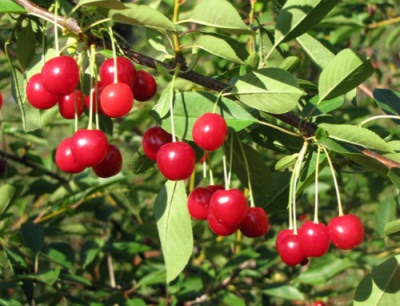
- Authors: Gvozdyukova N.I., Isakova M.G.
- Appeared when crossing: Spring × (Spectacular x Surprise x Rossoshanskaya black x Large-fruited)
- Year of approval: 2019
- Barrel type: wood
- Crown: medium density, semi-erect shape
- Foliage: good
- Escapes: medium, straight, naked, gray in color
- Leaves: medium-sized, obovate, dark green in color, double-edged
- Flowering and fruiting type: on bouquet branches, annual growth
- Fruit size: large
Cherry Vita is a popular dwarf variety that is ideal for planting in small areas due to its compact size. Gardeners also appreciate the variety for its excellent yields and the ability to use fruits for harvesting.
Breeding history
The variety was bred by breeders N.I. Gvozdyukova and M.G. Isakova at the end of the 2010s. Scientists managed to get a variety that has strong resistance to low temperatures and most diseases. In 2019, the Vita cherry was entered in the State Register.
Description of the variety
Cherry Vita is a dwarf variety that begins to form fruits quite early in comparison with other trees. Characteristics of the culture.
Compact bushes, the height of which does not exceed 2 meters.
Leaves of deep dark green color, narrow oval shape.
White flowers, which during the growing season are formed into inflorescences of 4-5 pieces each.
Careful plant care will ensure stable fruiting and high yields.
Fruit characteristics
During the fruiting period, cherries form small berries, the average weight of which is 4 g. The difference in the culture is that the fruits grow densely on the branches of undersized bushes. Other characteristics:
round form;
reddish tint;
dense rind.
Cherries are suitable for fresh consumption and preparation of various preparations.
Taste qualities
Vita fruits are characterized by a sour taste. Pulp characteristics:
moderate density;
high rate of juiciness;
dark red color.
Tasters rated the taste of berries at 4.8 points out of 5. The fruit contains a large amount of nutrients and vitamins.
Ripening and fruiting
Early cherries begin to form fruits by mid-July. The peculiarity of the variety is early maturity, since the trees begin to bear fruit already in the fourth year of the growing season.

Yield
Cherries have excellent yields that attract gardeners. On average, it is possible to collect up to 25.8 centners of fruits per hectare.
Self-fertility and the need for pollinators
Vita is a partially self-fertile variety that, if necessary or grown in harsh conditions, is able to independently pollinate flowers to form fruits. More often other plants act as pollinators, for example, Samsonovka or Chernokorka.
Landing
The optimal time for planting cherry seedlings is spring, when the outside temperature is above zero. The variety can be grown outdoors, while planting is possible in small areas.The landing pattern implies maintaining the following distances:
2.5 m between seedlings;
3.5 m between rows.
Gardeners do not advise planting trees that are densely unstable to fungal diseases. The procedure is standard. Before planting, it is necessary to fertilize the soil and loosen the soil in order to saturate it with oxygen.


Growing and care
Cherry Vita has medium drought tolerance, so the plant is demanding to care for. First of all, the variety needs to provide sufficient watering so that the bushes do not suffer from a lack or excess of moisture.
Before watering, you should pay attention to the condition of the soil. If it is saturated with moisture, you can postpone the procedure for a couple of days. Gardeners recommend increasing the amount of liquid introduced into the soil during the growing season of the plant, the formation of ovaries and the filling of fruits.
It is worth taking care of the timely fertilization of the soil.
During the fruiting period, the soil can be additionally fertilized with organic compounds: peat, compost or humus.


Disease and pest resistance
Cherries have strong immunity. However, the tree is unstable to a number of diseases. Common:
coccomycosis;
moniliosis.
For prevention purposes, it is recommended to treat the bushes with drugs that contain copper. It is worth spraying trees 3 times per season, but not during the fruiting period, so as not to spoil the berries.
Ardent pests of cherries are:
aphid;
slimy sawfly.
Insects damage leaves and fruits, and to eliminate them, it is necessary to treat the bushes with folk remedies or special compounds.
Requirements for soil and climatic conditions
Spectacular cherries are ideal for growing in regions where winters are harsh. The tree is resistant to low temperatures, maintaining the quality of the fruit. However, in order to avoid freezing of buds and bark, it is recommended to cover young seedlings for the period of frost, and mulch the soil using peat or sawdust.
































































